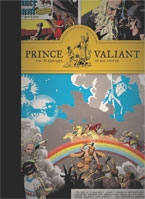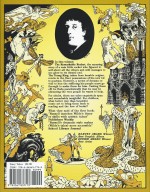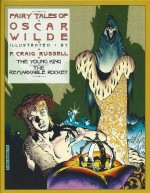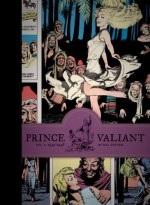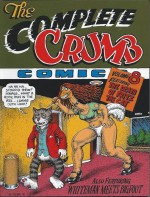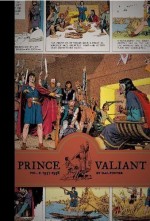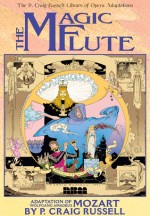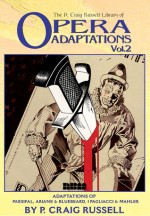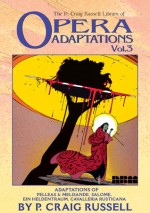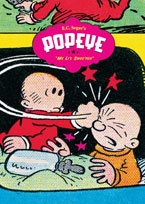
By Elzie Crisler Segar, with Doc Winner (Fantagraphics Books)
ISBN: 978-1-60699-483-2
Elzie Crisler Segar was born in Chester, Illinois on 8th December 1894. His father was a handyman, and the boy’s early life was filled with the kinds of solid, dependable blue-collar jobs that typified his generation of cartoonists. He worked as a decorator and house-painter and also played drums; accompanying vaudeville acts at the local theatre.
When the town got a movie-house he played for the silent films, absorbing all the staging, timing and narrative tricks from keen observation of the screen. Those lessons would become his greatest assets as a cartoonist. It was while working as the film projectionist, aged 18, that he decided to become a cartoonist and tell his own stories.
Like so many others he studied art via mail, in this case W.L. Evans’ cartooning correspondence course out of Cleveland, Ohio, before gravitating to Chicago where he was “discovered†by Richard F. Outcault – regarded by most as the inventor of newspaper comic strips with The Yellow Kid and, later, Buster Brown.
The celebrated cartoonist introduced him around at the prestigious Chicago Herald. Still wet behind the ears, Segar’s first strip, Charley Chaplin’s Comedy Capers, debuted on 12th March 1916. In 1918 he married Myrtle Johnson and moved to William Randolph Hearst’s Chicago Evening American to create Looping the Loop, but Managing Editor William Curley saw a big future for Segar and packed the newlyweds off to New York, HQ of the mighty King Features Syndicate.
Within a year Segar was producing Thimble Theatre, which launched December 19th 1919 in the New York Journal. It was a pastiche of movie-inspired features like Hairbreadth Harry and Midget Movies, with a repertory cast to act out comedies, melodramas, comedies, crime-stories, chases and especially comedies for vast daily audiences. The core cast included parental pillars Nana and Cole Oyl, their lanky highly-strung daughter Olive, diminutive-but-pushy son Castor and Olive’s plain and simple occasional boyfriend Horace Hamgravy (later known as just Ham Gravy).
In 1924 Segar created a second daily strip The 5:15: a surreal domestic comedy featuring weedy commuter and would-be inventor John Sappo and his formidable wife Myrtle (surely, no relation?) which endured – in one form or another – as a topper/footer-feature accompanying the main Sunday page throughout the author’s career, even surviving his untimely death, eventually becoming the trainee-playground of Popeye’s second great stylist Bud Sagendorf.
A born storyteller, Segar had from the start an advantage even his beloved cinema couldn’t match: a brilliant ear for dialogue and accent which boomed out from his admittedly average adventure plots, adding lustre and sheer sparkle to stories and gags he always felt he hadn’t drawn well enough. After a decade or so – and just as cinema caught up with the invention of “talkies†– he finally discovered a character whose unique sound and individual vocalisations blended with a fantastic, enthralling nature to create a literal superstar.
Popeye the sailor, brusque, incoherent, plug-ugly and stingingly sarcastic, lurched on stage midway through the protracted continuity ‘Dice Island’, (on January 17th 1929: see E.C. Segar’s Popeye volume 1: “I Yam What I Yam!â€) and, once his part was played out, simply refused to leave.
Within a year he was a regular and, as the strip’s circulation skyrocketed, he gradually took his place as the star. The strip title was changed to reflect the fact and most of the tired old gang – except Olive – consigned to oblivion …
The Old Salt clearly inspired his creator. The near decade of thrilling mystery-comedies he crafted and the madcap and/or macabre new characters with which he furiously littered the strips revolutionised the industry, laid the groundwork for the entire superhero genre (sadly, usually without the leavening underpinnings of his wryly self-aware humour) and utterly captivated the whole wide world.
These superb oversized (375 x 268 mm) hardback collections are the ideal way of discovering or rediscovering Segar’s magical tales, and this sixth and final mammoth compendium augments the fun with another an insightful introductory essay from Richard Marschall exploring ‘The Continuity Style of E. C. Segar: Between “Meanwhile†& “To Be Continued‑ and closes with an absorbing end-piece essay describing the globalisation of the character in ‘Licensing and Merchandising Move to Center Stage of the Thimble Theatre: Popeye Fisks his way into American Culture‘ plus a 1930 magazine feature graphically revealing the Sailor Man’s natal origins and boyhood in ‘Blow Me Down! Popeye Born at Age of 2, But Orphink from Start’ scripted by unknown King Features writers but gloriously and copiously illustrated by Segar himself.
As always the black-&-white Daily continuities are presented separately to the full-colour Sunday’s, and the monochrome mirth and mayhem – covering December 14th 1936 to August 29th 1938 12th – begins with an all new adventure ‘Mystery Melody’ wherein Popeye’s disreputable dad Poopdeck Pappy is haunted and hunted by the sinister Sea Hag whose ghastly Magic Flute is employed to lure the old goat back into the clutches of the woman he loved and abandoned years ago…
The tension and drama grows in the second chapter ‘Tea and Hamburgers’ when the Hag approaches another old flame – J. Wellington Wimpy – and uses the reprobate’s insatiable lust (for food) to help capture Poopdeck. The plan works, but not quite as the sinister sorceress intended…
In ‘Bolo vs Everyone!’ events escalate completely beyond control as the Hag’s primordial man-monster attacks and the grizzled mariner ends the fight in his own inimitable manner, whilst mystic marvel Eugene the Jeep (a fantastic 4th dimensional beast with incredible powers) uses his gifts to temporarily settle the Sea Hag’s hash…
A decided change of pace began with the next storyline. ‘A Sock for Susan’s Sake’ showcases Popeye’s big heart and sentimental nature as he takes a destitute and starving waif under his wing: buying her clothes, breaking her out of jail and going on the run with her.
His kind-hearted deeds arouse deep suspicions about his motives from friends and strangers alike…
It’s a tribute to Segar’s skills that the storyline perfectly balances social commentary and pathos with plenty of action (that sock in question is not footwear) and non-stop slapstick comedy. Their peregrinations again land Susan and the Old Salt in jail – for vagrancy – but the wonderfully sympathetic and easily amused Judge Penny really makes the prosecution work hilariously hard for a conviction in ‘Order in the Court!’…
Naturally, jealous Olive gets completely the wrong idea and uses the Jeep to track down her straying beau in ‘Who is That Girl?’ leading to the discovery of the ingénue’s origins and the restoration of her stolen fortune – a case calling for the return of ace detective and former strip star Castor Oyl…
The grateful child and her father burden Popeye with a huge reward but as he has his own adequate savings at home he gives it all – with some unexpected difficulty – away to “Widdies and Orphinksâ€â€¦
In the next sequence the Sailor Man has reason to regret that generosity as, on returning to his house, he finds his hard-earned “Ten Thousing dollars†savings have been stolen…
Most annoyingly he knows Poopdeck has taken it but the old goat won’t admit it, even though he has a new diamond engagement ring which he uses to bribe various loose young (and not so young) women into going out gallivanting with him and sowing ‘Wild Oats’ …
When Popeye first appeared he was a rough, rude, crude and shocking anti-hero. The first Superman of comics was not a comfortable paragon to idolise but a barely human brute who thought with his fists and didn’t respect authority. Uneducated, opinionated, short-tempered, fickle (whenever hot tomatoes batted their eyelashes – or thereabouts – at him), a gambler and troublemaker, he wasn’t welcome in polite society…and he wouldn’t want to be.
He was soon exposed as the ultimate working class hero: raw and rough-hewn, practical, but with an innate and unshakable sense of what’s fair and what’s not, a joker who wanted kids to be themselves – but not necessarily “good†– and somebody who took no guff from anyone.
As his popularity grew he somewhat mellowed. He was always ready to defend the weak and had absolutely no pretensions or aspirations to rise above his fellows. He was and will always be “the best of usâ€â€¦ but the shocking sense of unpredictability, danger and comedic anarchy he initially provided was sorely missed. So in 1936 Segar brought it all back again in the form of Popeye’s 99-year old unrepentantly reprobate dad…
The elder mariner was a rough, hard-bitten, grumpy brute quite prepared and even happy to cheat, steal or smack a woman around if she stepped out of line, and once the old Billy goat (whose shady past possibly concealed an occasional bit of piracy) was firmly established, Segar set Popeye and Olive the Herculean and unfailingly funny task of civilising the old sod…
They returned to their odious chore here as Pappy’s wild carousing, fighting and womanising grow ever more embarrassing and lead to the cops trying – and repeatedly failing – to jail the senior seaman.
Poopdeck finally goes too far and pushes one of his fancy woman fiancées into the river. At last brought to trial, he pleads ‘Extenuvatin’ Circumsnances’…
The final full saga began on 15th November 1937 as ‘The Valley of the Goons (An Adventure)’ saw Popeye and Wimpy drugged and shanghaied. Even though he could fight his way back home, Popeye agrees to stay on for the voyage since he needs money to pay lawyers appealing Pappy’s prison sentence. He quickly changes tack, however, when he discovers the valuable cargo they’re hunting is Goon skins! The Cap’n and his scurvy crew are planning to slaughter the hapless hulking exotic primitives for a few measly dollars…
After brutally driving off the murderous thugs, Popeye – and the shirking Wimpy – are marooned on the Goons’ isolated island…
The barbaric land holds a few surprises: most notably the fact that the natives are ruled over by Popeye’s dour old pal King Blozo (formerly of Nazilia) who, with his idiot retainer Oscar, is calling all the shots. It’s a happy coincidence as Wimpy’s eternal hunger and relentless mooching have won him a death sentence and he’s in imminent danger of being hanged…
All this time Olive, guided by the mystical tracking gifts of the Jeep, has been sailing the seven seas in search of her man and she beaches her boat just as Popeye begins to get the situation under control. In doing so he unfairly earns the chagrin of the island’s unseen but highly voluble sea monster George…
Shock follows shock as the eerie voiced unseen creature is revealed as the horrendous Sea Hag who re-exerts her uncanny hold (some illusions but mostly the promise of unlimited hamburgers) upon Wimpy and tries to make him the ‘Bride of George’…
In the middle of this tale Segar fell seriously ill with Leukaemia and his assistant Doc Winner assumed responsibility for completing the story: probably from Segar’s notes if not at his actual direction.
Although Winner’s illustrations carry ‘Valley of the Goons’ to conclusion, this tome excludes the all-Winner adventure ‘Hamburger Sharks and Sea Spinach’ before resuming with the May 23rd instalment by the apparently recovered Segar.
‘King Swee’Pea’ saw the feisty baby – who had been left with Popeye – become the focus of political drama and family tension when he was revealed to be heir to the Kingdom of Demonia…
After a protracted tussle with that nation’s secret service and bombastic kingmaker F.G. Frogfuzz Esquire, the Sailor Man has himself appointed regent and chief advisor and, taking most of the cast with him, relocates to the harsh land where only Ka-babages grow.
Popeye soon finds that his mischievous little charge has started to speak: increasingly crossing and contradicting his gruff guardian and others, much to the annoyance of blustering bully King Cabooso of neighbouring (rival) nation Cuspidonia…
Before long another unique crisis manifests in ‘Rise of the De-Mings’ as smug and sassy subterranean critters begin devastating the Ka-babage crop even as Swee’Pea and Caboosa escalate their war of insults…
Sadly, although coming back strongly, within three months Segar had relapsed. The adventures end here with his last strip and a précis of Winner’s eventual conclusion…
Segar passed away six weeks after his final Daily strip was published.
The full-colour Sunday pages in this volume run from 20th September 1936 to October 2nd 1938, a combination of Star turn and intriguing footers.
After an interlude with a new wry and charming feature – Pete and Patsy: For Kids Only – the artist settled once again upon an old favourite to back up Popeye.
The bizarrely entertaining Sappo (and the scene-and show-stealing Professor O.G. Wotasnozzle) supplemental strip returned in a blaze of imaginative wonder, as Segar also benched the cartooning tricks section which allowed him to play graphic games with his readership and again pushed the boundaries of Weird Science as the Odd Couple – and long-suffering spouse Myrtle – spent months exploring other worlds.
The assorted Saps also dabbled with robot dogs, brain-switching machines and fell embarrassingly foul of such inventions as long-distance spy-rays, anti-gravity devices, limb extending “Stretcholeneâ€, “Speak-no-Evil†pills, Atom-Counters and the deeply disturbing trouble magnet dubbed “Dream Solidifier†whilst Sappo’s less scientific but far more profitable gimmicks kept the cash rolling in and the arrogant Professor steaming with outrage…
Above these arcane antics Sunday’s star attraction remained fixedly exploring the comedy gold of Popeye’s interactions with Wimpy, Olive Oyl and the rest of Segar’s cast of thousands (of idiots).
The humorous antics – in sequences of one-off gag strips alternating with the occasional extended saga – saw the Sailor-Man fighting for every iota of attention whilst his mournful mooching co-star became increasingly more ingenious – not to say surreal – in his quest for free meals…
An engaging Micawber-like coward, cad and conman, the insatiable J. Wellington Wimpy debuted on May 3rd 1931 as an unnamed and decidedly partisan referee in one of Popeye’s frequent boxing matches. The scurrilous but polite oaf obviously struck a chord and Segar gradually made him a fixture. Always hungry, keen to take bribes and a cunning coiner of many immortal catchphrases – such as “I would gladly pay you Tuesday for a hamburger today†and ‘Let’s you and him fight’ – he was the perfect foil for a simple action hero and increasingly stole the entire show just like anything else unless it was nailed down…
There was also a long-suffering returning rival for Olive’s dubious and flighty affections: local charmer Curly…
When not beating the stuffing out of his opponents or kissing pretty girls, Popeye pursued his flighty, vacillating and irresolute Olive with exceptional verve, if little success, but his life was always made more complicated whenever the unflappable, so-corruptible and adorably contemptible Wimpy made an appearance.
Infinitely varying riffs on Olive’s peculiar romantic notions or Wimpy’s attempts to cadge food or money (for food) were irresistible to the adoring readership, but Segar wisely peppered the Sundays with longer episodic tales, such as the saga of ‘The Terrible Kid Mustard’ (which ran from December 27th 1936 to February 28th 1937) and pitted the prize-fighting Sea Salt against another boxer who was as ferociously fuelled by the incredible nourishing power of Spinach…
Another extended endeavour starred the smallest addition to the cast (and eponymous star of this volume). The rambunctious tyke Swee’Pea was never an angel and when he began stealing jam and framing Eugene the Jeep (March 7th through 28th) the search for a culprit proved he was also precociously smart too.
The impossible task of civilising Poopdeck Pappy also covered many months – with no appreciable or lasting effect – and incorporated an outrageous sequence wherein the dastardly dotard become scandalously, catastrophically entangled in Popeye’s mechanical diaper-changing machine…
On June 27th Wimpy found the closest thing to true love when he met Olive’s friend Waneeta: a meek, retiring soul whose father owned 50,000 cows. His devoted pursuit filled many pages over the following months, as did the latest scheme of his arch-nemesis George W. Geezil, who bought a café/diner with the sole intention of poisoning the constantly cadging conman…
Although starring the same characters the Sunday and Daily strips ran separate storylines, offering Segar opportunities to utilise the same good idea in different ways.
On September 19th 1937 he began a sequence wherein Swee’Pea’s mother returned, seeking to regain custody of the boy she gave away. The resultant tug-of-love tale ran until December 5th and displayed genuine warmth and angst amidst the wealth of hilarious antics by both parties to convince the feisty “infink†to pick his favourite parent…
On January 16th 1938 Popeye was approached by scientists who had stumbled upon an incipient Martian invasion. The invaders planned to pit their monster against a typical Earthman before committing to the assault and the Boffins believed that the grizzly old pug was the planet’s best bet…
Readers didn’t realise that the feature’s glory days were ending. Segar’s advancing illness was affecting his output – there are no pages reproduced here between February 6th and June 26th – and although when he resumed the gags were funnier than ever (especially a short sequence where Pappy shaves his beard and dyes his hair so he could impersonate Popeye and woo Olive) the long lead-in time necessary to create Sundays only left him time to finish more 15 pages.
The last Segar signed strip was published on October 2nd 1938. He died eleven days later.
There is more than one Popeye. If your first thought on hearing the name is an unintelligible, indomitable white-clad sailor always fighting a great big beardy-bloke and mainlining tinned spinach, that’s okay: the animated features have a brilliance and energy of their own (even the later, watered-down anodyne TV versions have some merit) and they are indeed based on the grizzled, crusty, foul-mouthed, bulletproof, golden-hearted old swab who shambled his way into Thimble Theatre and wouldn’t leave. But they are really only the tip of an incredible iceberg of satire, slapstick, virtue, vice and mind-boggling adventure…
Popeye and the bizarre, surreally quotidian cast that welcomed and grew up around him are true icons of international popular culture who have grown far beyond their newspaper strip origins. Nevertheless, in one very true sense, with this marvellous yet painfully tragic final volume, the most creative period in the saga of the true and only Sailor Man closes.
His last strips were often augmented or even fully ghosted by Doc Winner, but the intent is generally untrammelled, leaving an unparalleled testament to Segar’s incontestable timeless, manic brilliance for us all to enjoy over and over again.
There is more than one Popeye. Most of them are pretty good and some are truly excellent. However there was only ever one by Elzie Segar – and don’t you think it’s time you sampled the original and very best?
© 2012 Fantagraphics Books Inc. All comics and drawings © 2011 King Features Inc. All rights reserved.



